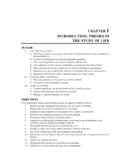Transcription of Life: The Science of Biology, Tenth Edition
1 DAVID SADAVA The Claremont CollegesDAVID University of TexasH. CRAIGHELLER Stanford UniversityMAY University of IllinoisLIFEThe Science of BiologyTENTH EDITIONMACMILLANSINAUER Sinauer Associates, Inc. This material cannot be copied, reproduced, manufactured or disseminated in any form without express written permission from the ONE THE Science OF life AND ITS CHEMICAL BASIS 1 Studying life 1 2 Small Molecules and the Chemistry of life 21 3 Proteins, Carbohydrates, and Lipids 39 4 Nucleic Acids and the Origin of life 62 PART TWO CELLS 5 Cells: The Working Units of life 77 6 Cell Membranes 105 7 Cell Communication and Multicellularity 125 PART THREE CELLS AND ENERGY 8 Energy, Enzymes, and Metabolism 144 9 Pathways that Harvest Chemical Energy 16510 Photosynthesis: Energy from Sunlight 185 PART FOUR GENES AND HEREDITY11 The Cell Cycle and Cell Division 20512 Inheritance, Genes, and Chromosomes 23213 DNA and Its Role in Heredity 25914 From DNA to Protein.
2 Gene Expression 28115 Gene Mutation and Molecular Medicine 30416 Regulation of Gene Expression 328 PART FIVE GENOMES 17 Genomes 35218 Recombinant DNA and Biotechnology 37319 Differential Gene Expression in Development 39220 Genes, Development, and Evolution 412 PART SIX THE PATTERNS AND PROCESSES OF EVOLUTION 21 Mechanisms of Evolution 42722 Reconstructing and Using Phylogenies 44923 Speciation 46724 Evolution of Genes and Genomes 48525 The History of life on Earth 505 PART SEVEN THE EVOLUTION OF DIVERSITY 26 Bacteria, Archaea, and Viruses 52527 The Origin and Diversifi cation of Eukaryotes 54928 Plants without Seeds: From Water to Land 56929 The Evolution of Seed Plants 58830 The Evolution and Diversity of Fungi 60831 Animal Origins and the Evolution of Body Plans 62932 Protostome Animals 65133 Deuterostome Animals 678 PART EIGHT FLOWERING PLANTS: FORM AND FUNCTION 34 The Plant Body 70835 Transport in Plants 72636 Plant Nutrition 74037 Regulation of Plant Growth 75638 Reproduction in Flowering Plants 77839 Plant Responses to Environmental Challenges 797 PART NINE ANIMALS: FORM AND FUNCTION40 Physiology, Homeostasis, and Temperature Regulation 81541 Animal Hormones 83442 Immunology.
3 Animal Defense Systems 85643 Animal Reproduction 88044 Animal Development 90245 Neurons, Glia, and Nervous Systems 92446 Sensory Systems 94647 The Mammalian Nervous System 96748 Musculoskeletal Systems 98649 Gas Exchange 100550 Circulatory Systems 102551 Nutrition, Digestion, and Absorption 104852 Salt and Water Balance and Nitrogen Excretion 107153 Animal Behavior 1093 PART TEN ECOLOGY54 Ecology and the Distribution of life 112155 Population Ecology 114956 Species Interactions and Coevolution 116957 Community Ecology 118858 Ecosystems and Global Ecology 120759 Biodiversity and Conservation biology 1228 Contents in Brief Sinauer Associates, Inc. This material cannot be copied, reproduced, manufactured or disseminated in any form without express written permission from the ONE The Science of life and Its Chemical Basis Studying life What Is biology ?
4 2 life arose from non- life via chemical evolution 3 Cellular structure evolved in the common ancestor of life 3 Photosynthesis allows some organisms to capture energy from the sun 4 biological information is contained in a genetic language common to all organisms 5 Populations of all living organisms evolve 6 Biologists can trace the evolutionary tree of life 6 Cellular specialization and differentiation underlie multicellular life 9 Living organisms interact with one another 9 Nutrients supply energy and are the basis of biosynthesis 10 Living organisms must regulate their internal environment How Do Biologists Investigate life ? 11 Observing and quantifying are important skills 11 Scientific methods combine observation, experimentation, and logic 11 Good experiments have the potential to falsify hypotheses 12 Statistical methods are essential scientific tools 13 Discoveries in biology can be generalized 14 Not all forms of inquiry are scientific Why Does biology Matter?
5 15 Modern agriculture depends on biology 15 biology is the basis of medical practice 15 biology can inform public policy 16 biology is crucial for understanding ecosystems 17 biology helps us understand and appreciate biodiversity 17 Small Molecules and the Chemistryof life How Does Atomic Structure Explain the Properties of Matter? 22An element consists of only one kind of atom 22 Each element has a unique number of protons 22 The number of neutrons differs among isotopes 22 The behavior of electrons determines chemical bonding and geometry How Do Atoms Bond to Form Molecules? 26 Covalent bonds consist of shared pairs of electrons 26 Ionic attractions form by electrical attraction 28 Hydrogen bonds may form within or between molecules with polar covalent bonds 30 Hydrophobic interactions bring together nonpolar molecules 30van der Waals forces involve contacts between atoms How Do Atoms Change Partners in Chemical Reactions?
6 What Makes Water So Important for life ? 32 Water has a unique structure and special properties 32 The reactions of life take place in aqueous solutions 33 Aqueous solutions may be acidic or basic 34 Proteins,Carbohydrates,and Lipids What Kinds of Molecules Characterize Living Things? 40 Functional groups give specific properties to biological molecules 40 Isomers have different arrangements of the same atoms 41 The structures of macromolecules reflect their functions 41123 Sinauer Associates, Inc. This material cannot be copied, reproduced, manufactured or disseminated in any form without express written permission from the Contents Most macromolecules are formed by condensation and broken down by hydrolysis What Are the Chemical Structures and Functions of Proteins? 42 Amino acids are the building blocks of proteins 43 Peptide linkages form the backbone of a protein 43 The primary structure of a protein is its amino acid sequence 45 The secondary structure of a protein requires hydrogen bonding 45 The tertiary structure of a protein is formed by bending and folding 46 The quaternary structure of a protein consists of subunits 48 Shape and surface chemistry contribute to protein function 48 Environmental conditions affect protein structure 50 Protein shapes can change 50 Molecular chaperones help shape proteins What Are the Chemical Structures and Functions of Carbohydrates?
7 51 Monosaccharides are simple sugars 52 Glycosidic linkages bond monosaccharides 53 Polysaccharides store energy and provide structural materials 53 Chemically modified carbohydrates contain additional functional groups What Are the Chemical Structures and Functions of Lipids? 56 Fats and oils are triglycerides 56 Phospholipids form biological membranes 57 Some lipids have roles in energy conversion, regulation, and protection 57 Nucleic Acidsand the Origin ofLife What Are the Chemical Structures and Functions of Nucleic Acids? 63 Nucleotides are the building blocks of nucleic acids 63 Base pairing occurs in both DNA and RNA 63 DNA carries information and is expressed through RNA 65 The DNA base sequence reveals evolutionary relationships 66 Nucleotides have other important roles How and Where Did the Small Molecules of life Originate?
8 67 Experiments disproved the spontaneous generation of life 67 life began in water 68 life may have come from outside Earth 69 Prebiotic synthesis experiments model early Earth How Did the Large Molecules of life Originate? 71 Chemical evolution may have led to polymerization 71 RNA may have been the first biological catalyst How Did the First Cells Originate? 71 Experiments explore the origin of cells 73 Some ancient cells left a fossil imprint 74 PART TWO CellsCells: The WorkingUnits of life What Features Make Cells the Fundamental Units of life ? 78 Cell size is limited by the surface area-to-volume ratio 78 Microscopes reveal the features of cells 79 The plasma membrane forms the outer surface of every cell 79 Cells are classified as either prokaryotic or eukaryotic What Features Characterize Prokaryotic Cells? 82 Prokaryotic cells share certain features 82 Specialized features are found in some prokaryotes What Features Characterize Eukaryotic Cells?
9 84 Compartmentalization is the key to eukaryotic cell function 84 Organelles can be studied by microscopy or isolated for chemical analysis 84 Ribosomes are factories for protein synthesis 84 The nucleus contains most of the generic information 85 The endomembrane system is a group of interrelated organelles 88 Some organelles transform energy 91 There are several other membrane-enclosed organelles 93 The cytoskeleton is important in cell structure and movement 94 Biologists can manipulate living systems to establish cause and effect What Are the Roles of Extracellular Structures? 99 The plant cell wall is an extracellular structure 99 The extracellular matrix supports tissue functions in animals How Did Eukaryotic Cells Originate? 101 Internal membranes and the nuclear envelope probably came from the plasma membrane 101 Some organelles arose by endosymbiosis 10245 Sinauer Associates, Inc.
10 This material cannot be copied, reproduced, manufactured or disseminated in any form without express written permission from the XXIII6 Cell Membranes What Is the Structure of a biological Membrane? 106 Lipids form the hydrophobic core of the membrane 106 Membrane proteins are asymmetrically distributed 107 Membranes are constantly changing 109 Plasma membrane carbohydrates are recognition sites How Is the Plasma Membrane Involved in Cell Adhesion and Recognition? 110 Cell recognition and adhesion involve proteins and carbohydrates at the cell surface 111 Three types of cell junctions connect adjacent cells 111 Cell membranes adhere to the extracellular matrix What Are the Passive Processes of Membrane Transport? 113 Diffusion is the process of random movement toward a state of equilibrium 113 Simple diffusion takes place through the phospholipid bilayer 114 Osmosis is the diffusion of water across membranes 114 Diffusion may be aided by channel proteins 115 Carrier proteins aid diffusion by binding substances What are the Active Processes of Membrane Transport?



















